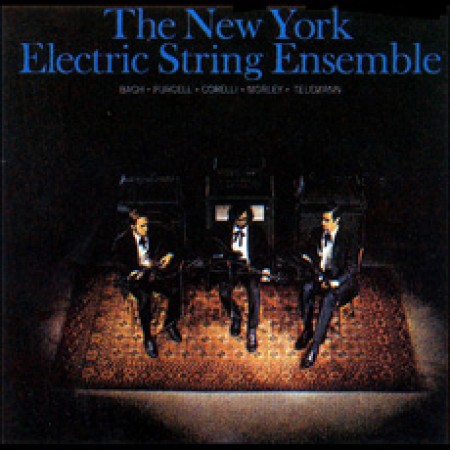The New York Electric String Ensemble
The New York Electric String Ensemble
When I talk about the New York Electric String Ensemble I have to talk about John Talbot. I first met him in his (and my own) "golden years" when the band I'm in was setting the crowds to swinging and swaying at the famous Hippodrome Lounge in scenic Marvin Gardens. Talbot approached me between sets and announced in broken English that he was going to be our bass player. My immediate impulse, as I recall, was to step on his artist's fingers, but I thought that he might be a goon from the union on a busman's holiday so I said "Sure, kid." and one can imagine my surprise, chagrin, etc., etc. when he presented himself, freshly scrubbed and shorn, new caps gleaming, at the band shell the following night, thirty five-dollar Japanese bass straining at the seams of its brown paper case. The rest is history - within the next two months we were recording hit after hit for those nice men at Columbia Records, and we soon earned the undying respect and adulation of concert-goers everywhere. But somehow the pinnacle of success was too pointed to support Talbot's ambitions and, sure enough, one day he announced - it was at Ben's Delicatessen in Montreal - "'tis better to rule in Hell than to serve in Heaven!" - a pearl of rhetoric gleaned from the Book-O'-the-Month Club condensation of J. Milton's widely acclaimed travelogue. Then he was gone.
Several months later, Talbot called me and told me that he had organized a small band - himself and two other persons - and would I like to play drums. I switched off "Peyton Place," jumped into my newly pressed sunsuit and dashed off to what is now the United Nations Center and played with the "Jonathan-Talbot Group" for three days. It was then that I discovered that the act was merely a front for the more ambitious project herein contained. Jon swore me to secrecy, which I betrayed often through fits of giggling, because the idea of applying current instrumentation to the classics is an absurdly simple one.
The result is a serious interpretation of the music - as opposed to the sophistry of the Swingles - rendered by three musical literates who learned it all by brute force. The fact that they have recorded forty-odd minutes of quite difficult material is astounding. As Ronald Reagan would say: "It shows what hard work, discipline, and good old American know-how can do".
The other two illiterates are Lew Bottomly and Pete Smith. Lew is automatically suspect because he plays left-handed. He looks like American Gothic (the figure in the middle) in a Mustang. He would be an asset to any group (despite his left-handedness) because of his unflagging dedication to avarice. Pete I've known as long as I've been in Dirt City and he can tell you all the inside dope on counterfeit Martin guitars and genuine Indian Motorcycles. He's an incredibly good guitarist.
Which brings us to the end of the liner notes. If you're like me, you'll have been reading these while listening to the music; obviously one of the two must suffer, so with all proper deference may I suggest that you start the record over.
Gus Duffy
Personnel
Peter Smith, guitarJonathan Talbot, bass
Lewis Bottomly, guitar)
Track Listing
1.MORLEY: Springtime 2.MORLEY: Aria I 3.MORLEY: Aria II 4.BACH: Fugue No. 2 From "The Well Tempered Clavier" 5.PURCELL: Minuet From "First Harpsichord Suite" 6.TELEMANN: Sarabande From "Eine Kleine Suite Der Tafelmusik" 7.TELEMANN: Minuet From "Eine Kleine Suite Der Tafelmusik" 8.BACH: Minuet From "Notenbuchlein Fur Anna-Magdalena Bach" 9.BACH: Minuet Trio From "Klavierbuchlein Fur Friedemann Bach" 10.BACH: Polonaise From "Notenbuchlein Fur Anna-Magdalena Bach" 11.BACH: Gavotte From "Third English Suite" 12.BACH: Bouree From "Klavierbuchlein Fur Friedemann Bach" 13.CORELLI: Sonata In A Major Op. 4 No. 3 Largo 14.CORELLI: Sonata In A Major Op. 4 No. 3 Allegro 15.CORELLI: Sonata In A Major Op. 4 No. 3 Largo 16.CORELLI: Sonata In A Major Op. 4 No. 3 Allegro
Regent Sound Studios, NYC, July 24 & 25, 1967
Amplifiers courtesy of the Thomas Organ Company, Vox Division; Qntiue Bokara courtesy of Kent Costikyan Inc., 305 E. 63rd st., New York City.
This album was recorded July 24 and 28, 1967 at Regent Sound Studios in New York City under the direction of Bob Liftin. The A and R men were Ed Brewer and Jim Mason.
History
Original Lp
 Lp - Fontana Reissue
Lp - Fontana Reissue Photos provided by www.totalshutdown.com
Photos provided by www.totalshutdown.com
Play the samples
| PURCHASE OPTIONS | |
| Digital download | Choice of WAVS or MP3s |

